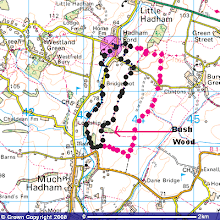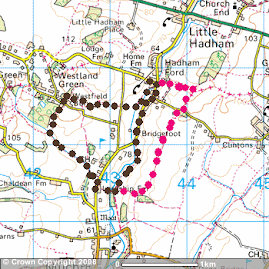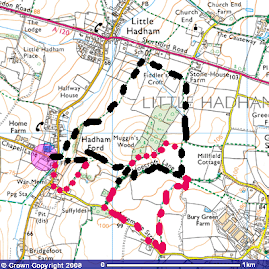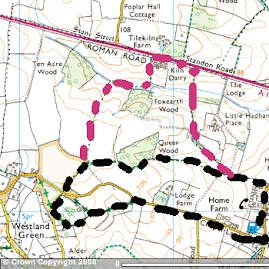


A morning walk along the Ridge footpath to Bush Wood and on to Winding Hill before crossing the River Ash and heading up the footpath that runs parallel to the 1st and 2nd fairways of the golf course. This path leads to Caley Wood and hence on to the rest of the golf course and finally back to the Ford. A reasonable selection of regular birds were about, with over 200 swallows and martins, mainly house but with a few sands, all migrating south along the Ash valley. Also, large numbers of starlings (75+) were congregating on wires along New Road and over 200 jackdaws, rooks and crows were foraging on the recently cropped fields. In with these was the leucistic jackdaw, which appears to be accepted by the others, but not the magpies who invariably chase it endlessly.
Also seen were yellowhammers, great spotted woodpecker, green woodpecker and a lone lesser black backed gull was noted on a ploughed field. A kestrel hovered over the golf course as a family party of 4 pied wagtails scurried around in the newly mown rough. A solitary moorhen was snapped on the Ash behind Lordship farmhouse.
Insects were observed in good numbers. Butterflies seen were meadow brown (12), small skipper (2), small white (26+), speckled wood (6) large white (2), green veined white (2) and holly blue (2).
7 migrant hawkers were observed, whilst a southern hawker was photographed, shown here. This one was photographed roosting on the hedgerow along the Ridge path. Also along here, a common darter dragonfly was also seen but moved too quickly for a photo.

Also seen were yellowhammers, great spotted woodpecker, green woodpecker and a lone lesser black backed gull was noted on a ploughed field. A kestrel hovered over the golf course as a family party of 4 pied wagtails scurried around in the newly mown rough. A solitary moorhen was snapped on the Ash behind Lordship farmhouse.
Insects were observed in good numbers. Butterflies seen were meadow brown (12), small skipper (2), small white (26+), speckled wood (6) large white (2), green veined white (2) and holly blue (2).
7 migrant hawkers were observed, whilst a southern hawker was photographed, shown here. This one was photographed roosting on the hedgerow along the Ridge path. Also along here, a common darter dragonfly was also seen but moved too quickly for a photo.


Photos today show the southern hawker dragonfly, the yellow triangle on the second abdomenal segment being diagnostic of this species. speckled wood butterfly is also depicted along with the moorhen, grey squirrel and a secretive muntjac.





























































































